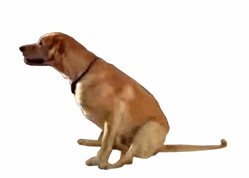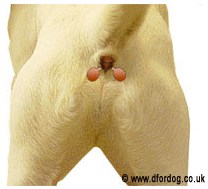Anal Glands: We “express” an understanding of the “root cause” of problems that arise
Most dogs at some time in their lives can be caught doing the ‘boot-scootin’ boogie’ on your carpet while you cry, “nooooo….”(in embarrassment, if there are guests! Lol) There are many possible reasons for this behavior, but most times its to relieve itchy, irritated, inflamed, or even impacted anal glands. The most common causes of anal gland issues are diet (stool issues), trauma to the glands, tilted glands (most are at ‘8 and 4’ o’clock positions, but can be at 7 and 2, causing some discomfort) So the location of the glands can be an issue too. It’s best to not just treat the symptoms, but instead, get to the root cause instead of putting just a band-aid fix on it—get rid of it entirely! After ruling out a physiological issue or injury causing the symptoms, let’s look at how this plays out…
Typically, dogs select soft surfaces to scoot on such as carpets, area rugs, fabric-covered surfaces or grass if they’re outdoors.
Why do Canines have Anal Glands?
Your dog’s anal glands or sacs are small and oval-shaped and sit just inside the rectum on either side of the anus at about the 8:00 and 4:00 o’clock positions. They’re located within the muscle of the anal sphincter and the tiny openings to the ducts aren’t easily visible along the anal mucosal junction.
The glands secrete an oily substance with a potent, “iron” type of odor that humans perceive as unpleasant, to put it mildly. This fluid usually functions as a territorial marker in the world of canine communication,”… allowing dogs to leave personal biochemical information for other dogs to investigate.” (Dr. Karen Becker, DVM)
When your dog poops an oily fluid is also expelled from the anal glands through tiny ducts and onto the feces. Anal glands empty from the pressure of the stool as it passes through the rectum and anus . This is how it should occur by nature, but unfortunately, today’s dogs often have loose stools or irregular bowel movements (soft, smelly, ‘kibbly’–whereas, raw diet has no smell or odor and is very small) that don’t provide sufficient pressure against the anal glands when they relieve their bowels.
“Scooting,” is the behavior, as we refer to it when they do this ‘fancy dance.’ It can also be due to pinworms or other parasites, so be sure to rule that out before heading to the vet to get them extracted. In other cases, there are other symptoms such as weight loss, poor coat or skin condition, a distended abdomen, or diarrhea. (if you see small “tape-like” things sticking to your labby’s backside, it may be tapeworm) Your vet can prescribe a one-time cure for it, easily.
Scooting can signal a problem like a tumor or irritation caused by diarrhea or a yeast infection, but most often the reason is an anal gland issue. So be sure to rule out a tumor or yeast infection with your vet first thing.
Cleaning Up Your Dog’s Diet can be the easiest solution to this scootin’ issue!
“If your dog is experiencing re-occurring anal gland issues it means there’s inflammation present and the first thing you should do is address the most logical causes of inflammation, the first step being food. Eliminate excess inflammatory foods from her diet, including all sources of grains and legumes (chickpeas, soy, beans, etc). Stop feeding any food that contains corn, potato, oatmeal, wheat, rice or soy.
Many veterinarians nutritionists, like Dr. Becker, also recommend ordering a NutriScan test to identify food sensitivities, followed by a novel diet depending on the results of the scan. When a dog is having a reaction to something in her diet, her body needs a break from that food. A one day fast before starting a new food is highly recommended. After determining her food intolerance(s) a novel, species-appropriate diet, should be introduced to promote healing. This means transitioning her to a different food she isn’t sensitive to, that is evolutionary for canines, and species-appropriate for them, and is made up of ingredients her body is familiar with and nutrients it craves.
Unfortunately, many dog foods claiming to contain “novel proteins,” don’t (instead they add legumes (beans and nuts!), which are not species-appropriate for canines–and a cheap way to cut costs on “real meat”). In addition, pet food mislabeling is a widespread problem, so if you’re planning to go with a commercially available processed novel diet, be aware it will almost undoubtedly contain ingredients you’re trying to avoid.
Adding probiotics, fiber (for example, 100% canned pumpkin or slippery elm powder) and digestive enzymes to her diet can also assist in creating consistently firm stools. Resolve an episode of loose stools immediately with these suggestions and a bland meal to correct the bowel imbalance before it creates anal gland issues.
Routine expression of healthy anal glands is unnecessary, and unpleasant for both dog and human, and potentially harmful, so if you take your pet to a groomer, make sure to mention that no anal gland expression is necessary if you have changed diet and your dog is no longer having issues. Over time, regular manhandling of these little sacs can interfere with their ability to function as nature intended.





40 Comments